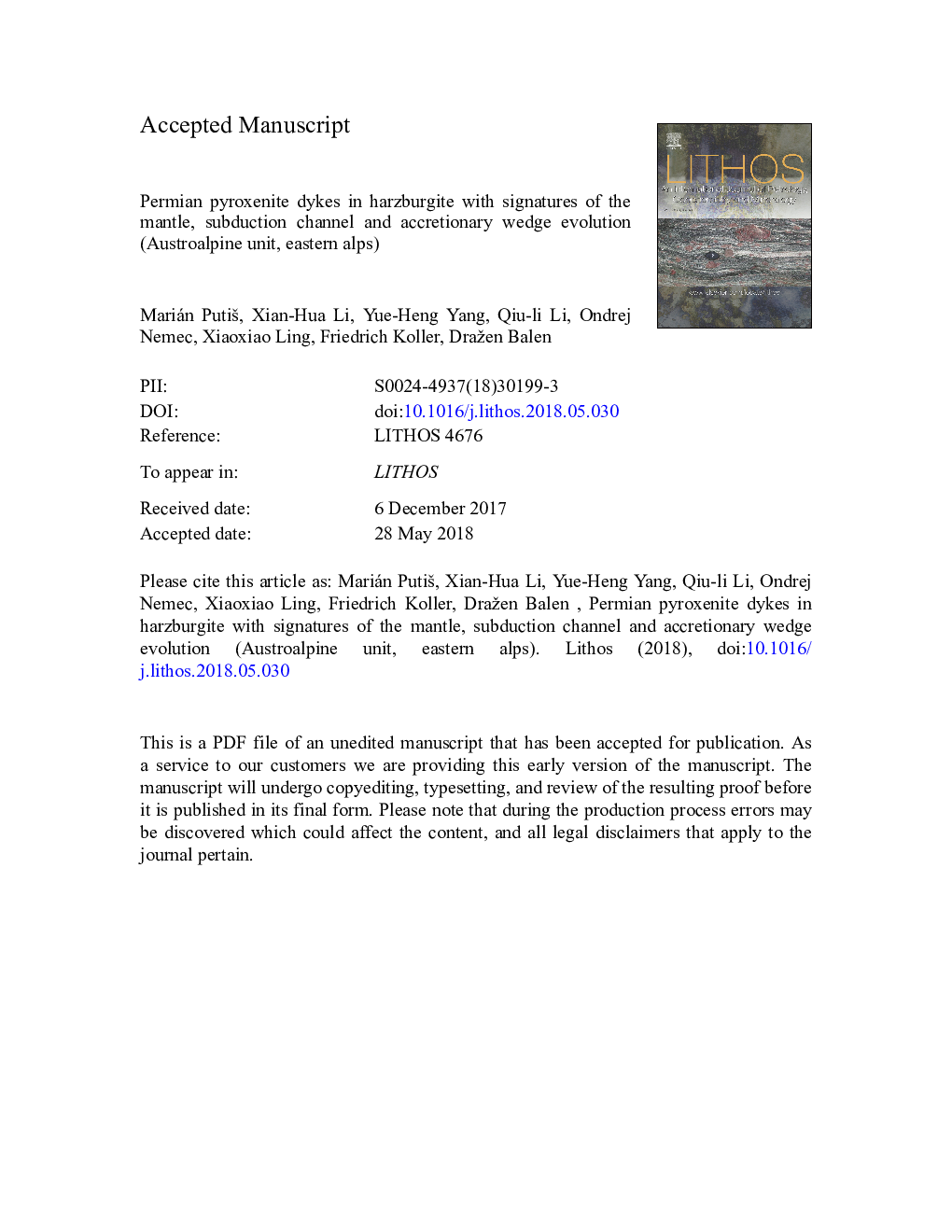| Article ID | Journal | Published Year | Pages | File Type |
|---|---|---|---|---|
| 8911546 | Lithos | 2018 | 71 Pages |
Abstract
Websterite and garnet orthopyroxenite and clinopyroxenite dykes crosscutting harzburgite occur in the hanging wall of a Cretaceous eclogitized continental fragment of the Upper Austroalpine Unit in the Eastern Alps. The dyke textures reflect pressure-temperature changes from the mantle, subduction channel and an accretionary wedge. A clinopyroxenite dyke, dated at 252â¯Â±â¯2â¯Ma on zircon by UPb SIMS, provided εHf(t) zircon values of 16-8 (av. 11 from 18 spots) suggesting a depleted mantle source. The rock modal mineral composition and the mineral and whole-rock chemistry revealed that the pyroxenite dykes' petrogenesis is most likely related to sub-crustal cumulate-type melt derivates, less evolved for websterites and highly evolved for clino- and orthopyroxenites. The porphyroclastic clinopyroxene1 (10-13â¯mol% Ca-Ts), orthopyroxene1, spinel1 and amphibole1 are inferred remnants after magmatic phases. They contain Ti-spinel and ilmenite exsolutions which indicate cooling of the dykes in harzburgite in a Spl stability field (D0-1 stage). Garnet exsolutions in Cpx1, Opx1 and Amp1, and Cpx exsolutions in Amp1 document continuous cooling and/or pressure increase (D0-2 stage). The Grt coronas around Spl1, Opx1, Cpx1 and Amp1, and the granoblastic matrix of Prp-Grs-rich Grt (or Cr-Spl in websterites), low-Al Cpx, low-Al Opx, Fe-enriched olivine, zoisite, kyanite, rutile and pargasite record a subduction channel compression (D1 stage). While the formation of Cpx-Grt or Amp-Grt symplectites replacing the Cpx1 and Amp1 rims suggests the HP-HT decompression (D2-1 exhumation stage). The Grt (or Cr-Spl) replacement by Spl, and Opx1, Cpx1 and Prg replacement by Ol-Spl, Opx-Spl or Prg-Spl symplectites document continuous HT decompression (D2-2 exhumation stage). The MP/MT-LT conditions were estimated from tremolite, Grs-rich Grt, Sr-epidote, clinozoisite, Cl-apatite, titanite, Ce-allanite, chlorite, serpentine and talc assemblage (D3 stage). Anticlockwise P-T path was reconstructed for the D0 to D1 stages followed by almost isothermal exhumation (D2) and emplacement in the Cretaceous accretionary wedge (D3). The pseudosection P-T calculation from a clinopyroxenite dyke yielded 850-825â¯Â°C and 25-28â¯kbar (D1). The whole-rock and mineral trace element data of relic Cpx1 and Amp1, Grt(1-3), Ep-Zo, and younger zircon ages due to Pb-loss, reflect the impact of metamorphic fluids during the D1 to D3 evolutionary stages.
Keywords
Related Topics
Physical Sciences and Engineering
Earth and Planetary Sciences
Geochemistry and Petrology
Authors
Marián PutiÅ¡, Xian-Hua Li, Yue-Heng Yang, Qiu-li Li, Ondrej Nemec, Xiaoxiao Ling, Friedrich Koller, Dražen Balen,
